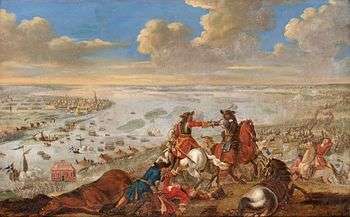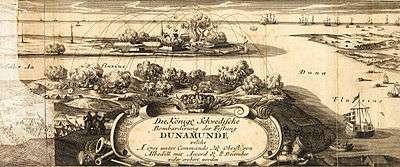Crossing of the Düna
| ||||||||||||||||||||||||||||||
The Crossing of the Düna (also known as Battle of Riga) took place during the Great Northern War on July 8 (Julian calendar) / July 9 (Swedish calendar) / July 19 (Gregorian calendar) 1701 near the city of Riga, present-day Latvia. The Swedish king Charles XII was in hot pursuit of king Augustus II the Strong of the Polish–Lithuanian Commonwealth and Saxony. The crossing was easily made, and the coalition troops were quickly broken and retreated.
Prelude
During the first year of fighting in the Great Northern War, Charles XII of Sweden had delivered two crushing defeats on his enemies. In July 1700, he forced Frederick IV of Denmark out of the coalition against Sweden, after a brief landing on Humlebæk. He then settled to aid the besieged Narva (which at the time belonged to the Swedish Empire). On his arrival, late November, he managed to decisively defeat the Russians despite being heavily outnumbered, in the battle of Narva, which led to an end of the Russian campaign for the year. Charles then turned his attention against the south and the Polish-Lithuanian Commonwealth to deal with his last opponent—August the Strong—before going into Russia.[5] The combined Saxon–Russian army of totally 29,000 men[2] had entrenched themselves across the 600 meter wide river of Düna under the command of Adam Heinrich von Steinau.[1]
Orders were sent from the Swedish king to the governor-general of Livonia, Erik Dahlbergh, in preparations for the crossing before the arrival of the Swedish main army. Dahlbergh was ordered to obtain around 200 landing boats of different sizes and was also instructed to build a bridge in order to transfer the cavalry across the river. The operation was supposed to be done in strict confidentiality to ensure a surprise attack on the enemies.[4] The Swedish army of 14,000 men[2] arrived at Riga on July 17, and already by the time, preparations for the attack were completed. However, bad weather ruined the Swedish plans to attack instantly, and the assault had to be postponed.[4] A Swedish cavalry regiment was left to threaten Kokenhusen, effectively forcing Steinau to split his forces,[3] thus the bulk of his army stayed across Riga.[4]
The allied army was initially under the command of Saxon general Otto Arnold von Paykull and Ferdinand Kettler of Courland, who were both ensured of an easy victory. In their confidence, they prioritized their numbers, advantageous position, redoubts and Saxon courage in superiority over the Swedes. Prior to the battle, Kettler pronounced: "even a superior force of three hundred thousands Swedes, would still not be enough, to successfully achieve any progress with the crossing". The Saxon army was, however, deployed a distance away from the beach, to ensure only a few Swedish regiments to land, before it would massively strike with its full capacity to drive the Swedes back and capture the Swedish king (who as they thought would be one among the few, to first step in land).[2]
Battle


During the evening of July 18, a little more than 6,000 Swedish infantry[1] and 535 cavalry troops[4] started to embark their landing boats in silence (there were about 195 boats of different structures and sizes, including four floating batteries with 10 cannons each and one corvette with 16 cannons).[1] Swedish guns from Riga had continually bombarded the allied entrenchments across the river the same day and would continue doing so throughout the night and landing.[4] After all the troops were embarked, the Swedes first torched some small boats on fire and pushed them out the river to obstruct the view for the allies with the deception (smoke),[6]:687 then at four o'clock in the morning of the 19th, the attack began.[4]
During their halfway reach, when the landing boats had gone around the island of Fossenholm (which had effectively blocked the sight of the Swedes), they got discovered and fired at. The four Swedish floating batteries returned fire, and after half an hour the Swedes reached the beach and was immediately thrown into fight against Saxon scouting patrols. When about 3,000 Swedish troops were ashore, the Saxons launched their first gathered assault of 3,500 men.[1] However, the Swedish force under the personal command of the king himself, would not retreat and the attack was beaten back. The Swedes then sequentially stormed and took the nearby Garras redoubt which seized them ground of at least 200 steps inshore where they managed to establish a good foothold, covering the ongoing construction of the floating bridge.
After having a brief stalemate, the Swedes formed up to initiate a second attack made by the Saxon general Otto Arnold von Paykull who strictly intended to drive them back before the arrival of further Swedish reinforcements. This attack, as the previous one, was repulsed. By this time the Saxon general Adam Heinrich von Steinau returned from Kokenhusen with large reinforcements and gained the command. He ordered a third assault on the Swedish stand, which at this time had almost every man ready from the landing. Since the Swedish left flank was protected by the river, Steinau gathered his cavalry in an attempt to attack the Swedish right which was rather unprotected. The attack had some success at first, but was subsequently beaten off after an ongoing attack in the rear by the Swedish cavalry.[4][2]
At seven o'clock in the morning, Saxon commander Heinrich von Steinau went for a council of war with his generals and decided to withdraw from the battle. Another wave was thrown at the Swedes in order to cover the retreat.[4] However, bad weather prevented final constructions of the bridge which denied the crossing of the Swedish cavalry and so August II slipped away with his army.[4] The Swedes lost 100 men dead and another 400 wounded.[4][1][7] The allied forces lost about 1,300 dead and wounded and another 700 captured. 36 artillery pieces and four standards and banners had also been conquered by the Swedes.[4]
Aftermath

After the battle Charles laid siege and took Mitau (where he gained 8,000 muskets and 9,000 pistols to his supplies) and then stormed the Cobron redoubt where 400 Russians were stationed, only after a massacre the redoubt was taken with as few as twenty Russians still alive. Charles later laid siege to Dünamunde and shortly after started persecuting the retreating forces who had initially been 20,000 men strong during the fighting. The 10,000 strong Russian force under Anikita Ivanovich Repnin retreated towards Russia after having scarcely been participating in the main battle. The Saxons retreated to neutral Prussia and thus left all of Courland open for Charles who seized the initiative and took Kokenhusen.[8][2][9]
In preparation for the crossing, king Charles XII had ordered to build the first bridge across the Daugava River, which was made of anchored and interconnected by ropes and boats. After the Swedish victory, the city was left with the structure. In 1705, the bridge, which had been lodged for the winter in Vējzaķsalas Bay, was washed away by the high spring waters. Later, the floating bridge was restored, but in 1710, it was again destroyed by the Russian army during the siege of Riga.[10]
During the battle, small barges armed with cannons were used, thus combining land and sea forces as well as deception (smoke) to achieve a stunning victory, carefully planned and very well executed. Participants included Otto Arnold von Paykull.[2]
See also
Sources
References
- 1 2 3 4 5 6 7 Ericson (2003), p. 268-273
- 1 2 3 4 5 6 7 8 9 10 Fryxell (1861), p. 157-161
- 1 2 Peterson (2007), p. 252
- 1 2 3 4 5 6 7 8 9 10 11 12 13 Larsson (2009), p. 108-111
- ↑ Sundberg (2010), p. 206
- ↑ Tucker, S.C., 2010, A Global Chronology of Conflict, Vol. Two, Santa Barbara: ABC-CLIO, LLC, ISBN 9781851096671
- ↑ Ullgren (2008), p. 80-82
- ↑ Kuvaja (2008), p. 148-153
- ↑ Svensson (2001), p. 61-62
- ↑ Riga municipality portal
Bibliography
- Olle Larsson, Stormaktens sista krig (2009) Lund, Historiska Media. ISBN 978-91-85873-59-3
- Ericson, Lars m fl: Svenska Slagfält, Wahlström & Widstrand 2003, ISBN 91-46-20225-0
- Peter Ullgren, Det stora nordiska kriget 1700-1721 (2008) Stockholm, Prisma. ISBN 978-91-518-5107-5
- Ericson, Sjöslag och rysshärjningar (2011) Stockholm, Norstedts. ISBN 978-91-1-303042-5
- Anders Fryxell, Berättelser ur svenska historien, Volym 21–22 (1861)
- Gary Dean Peterson, Warrior Kings of Sweden: The Rise of an Empire in the Sixteenth and Seventeenth Centuries (2007). McFarland.
- Ulf Sundberg, Sveriges krig 1630-1814 (2010) Svenskt Militärhistoriskt Bibliotek.
- Kuvaja, Christer, Krigen kring Östersjön - Karolinska krigare 1660-1721, Schildts Förlags AB, Helsingfors 2008
- Alex, Svensson, Karl XII som fältherre, Svenskt Militärhistoriskt Bibliotek, Stockholm 2001
Coordinates: 56°59′N 24°04′E / 56.983°N 24.067°E
